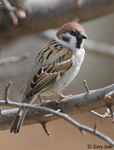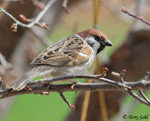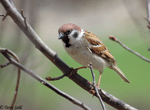| Length: 6 inches | Wingspan: 9 inches | Seasonality: Non-resident in South Dakota |
| ID Keys: Warm brown crown and nape (male) distinguish it from the House Sparrow. Black throat, dark cheek patch, light underparts, reddish-brown upperparst with dark streaking | ||
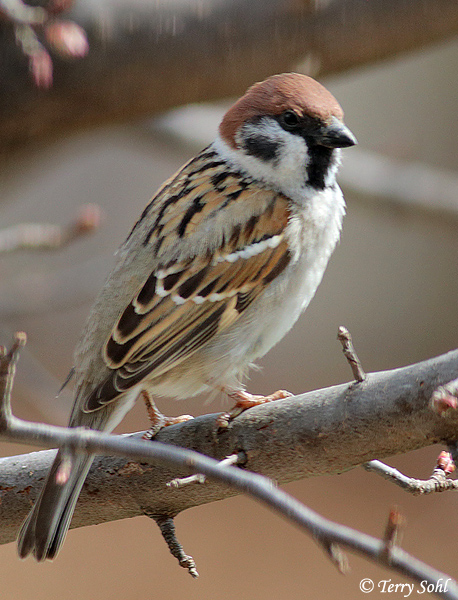 The
Eurasian Tree Sparrow is indeed a native of Europe and Asia. However,
in 1870, a businessman in St. Louis, Missouri received a shipment of
European birds from Germany, including 2 dozen Eurasian Tree Sparrows.
He released those sparrows in an effort to "enhance" the wildlife in the
region. While they have establish themselves in a small region around
St. Louis and have thrived until the present day, they have not widely
spread, like their introduced relative the
House Sparrow. In urban settings they do not compete well with
House Sparrows, and they are more often found in rural settings.
Occasional sightings of the species had been made in Wisconsin over the
years, and a handful of observations were made in Minnesota. In 2016,
two sightings occurred in the state of North Dakota. However, until April,
2018, the species was unknown in South Dakota, until a lone bird was
observed and photographed at the Gary and Jan Small residence in Vermillion,
South Dakota. Two weeks later, on May 3rd, 2018, two Eurasian Tree Sparrows
were found in Brandon, South Dakota...in my own yard! (Terry Sohl). Recent
research examining Christmas Bird Count data from 1951 through 2014 has
found a statistically significant expansion trend during that time frame,
indicating that after many decades of a very small, stable range around St.
Louis, they may now be increasing in number and expanding their range
northward.
The
Eurasian Tree Sparrow is indeed a native of Europe and Asia. However,
in 1870, a businessman in St. Louis, Missouri received a shipment of
European birds from Germany, including 2 dozen Eurasian Tree Sparrows.
He released those sparrows in an effort to "enhance" the wildlife in the
region. While they have establish themselves in a small region around
St. Louis and have thrived until the present day, they have not widely
spread, like their introduced relative the
House Sparrow. In urban settings they do not compete well with
House Sparrows, and they are more often found in rural settings.
Occasional sightings of the species had been made in Wisconsin over the
years, and a handful of observations were made in Minnesota. In 2016,
two sightings occurred in the state of North Dakota. However, until April,
2018, the species was unknown in South Dakota, until a lone bird was
observed and photographed at the Gary and Jan Small residence in Vermillion,
South Dakota. Two weeks later, on May 3rd, 2018, two Eurasian Tree Sparrows
were found in Brandon, South Dakota...in my own yard! (Terry Sohl). Recent
research examining Christmas Bird Count data from 1951 through 2014 has
found a statistically significant expansion trend during that time frame,
indicating that after many decades of a very small, stable range around St.
Louis, they may now be increasing in number and expanding their range
northward.
Habitat: Can be found in a wide range of habitats. They have adapted well to a human presence, and are often found in suburban areas and agricultural lands.
Diet: Feeds on seeds and grains, as well as insects, spiders, and other small invertebrates. They will also eat fruits and berries on occasion.
Behavior: Forages on the ground or low in vegetation.
Nesting: The nest is typically built in a crevice, tree cavity, or other such protected area. It is constructed of grasses, weeds, other vegetative material, and feathers. The female lays between 3 and 6 eggs, and she and the male will both incubate them. The young hatch after about 14 days.
Song: Various chip chip and tek tek calls
Migration: Considered a permanent resident throughout their normal range.
Interactive eBird map: Click here to access an interactive eBird map of Eurasian Tree Sparrow sightings
Similar Species: Most likely to be confused with the House Sparrow
Feeders: Eurasian Tree Sparrows will attend feeders for the standard offered seeds, as well as for suet and fruits.
Conservation Status: The population trend globally is stable, and they are found over a very wide geographic area. The IUCN lists the Eurasian Tree Sparrow as a species of "Least Concern".
Further Information: 1) Cornell's All About Birds - Eurasian Tree Sparrow
2) Audubon Guide - Eurasian Tree Sparrow
3) Birdlife International - Eurasian Tree Sparrow
4) Burnett, J.L., et al. 2017. Range Expansion by Passer montanus in North America. Biological Invasions 19(1): pp. 5-9. Research paper by Jessica L. Burnett, describing an analysis of Christmas Bird Count data from 1951 to 2014 that shows a statistically significant expansion trend to the north over that time period.
Photo Information: Photo by Terry Sohl - May 3rd, 2018 - Brandon, South Dakota
Photo Story: Until 2018, the Eurasian Tree Sparrow was unknown in South Dakota. A pair of sightings occurred in North Dakota in 2016, and there were also a handful of sightings in Minnesota. Given possible indications of range expansion in recent decades, perhaps it's not a surprise that the species showed up in the state in 2018. However, ANY time a new bird appears in a state, it's an event! The first Eurasian Tree Sparrow to be seen in South Dakota happened in mid-April in Vermillion, in the far southeastern edge of the state. The Small family, avid birders, saw a lone Eurasian Tree Sparrow in their yard. They were able to grab a confirming photograph, but the bird wasn't relocated after the initial sighting.
Fast forward to May 3rd, 2018....IN MY OWN YARD!! I was working at home that day, took a break at about 11:00 AM, looked out the sunroom window, and saw a number of bird foraging on the ground in the back of the yard. I grabbed my binoculars, and as I began to focus on a bird, it flew directly towards me, landing in a small crabapple tree right outside the window. Could it be? Yes...it was a Eurasian Tree Sparrow! Unmistakable with the rich, warm brown cap, the white cheek, and the black "ear patch". I stood there for a second, rather stunned. Then a second bird flew into the tree...another Eurasian Tree Sparrow! I was able to take a number of photos over the next minute and a half as the two hung out in the crabapple.
I saw a lone bird twice more that day, and haven't seen them since. But the two birds I saw represented only the 2nd and 3rd Eurasian Tree Sparrows that have been seen in South Dakota.
| Click below for a higher-resolution map |
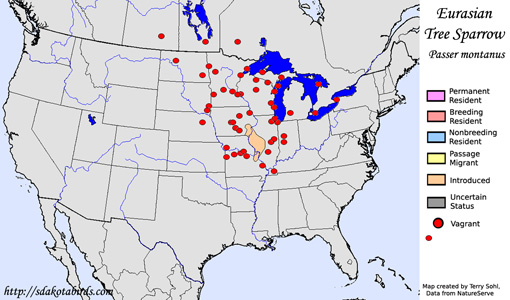 |
| South Dakota Status: The first sighting of the species in South Dakota was in 2018 (including two that appeared in my yard on May 3rd of that year). They are evidently spreading in range, but they are still considered extremely rare vagrants in South Dakota. |
Additional Eurasian Tree Sparrow Photos
